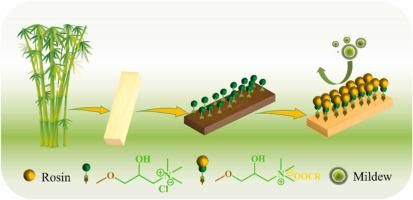Industrial Crops and Products ( IF 5.6 ) Pub Date : 2023-01-13 , DOI: 10.1016/j.indcrop.2023.116248 Yu Chen , Xin-Yao Ye , Da-Wei Wang , Jing Yang , Chun-Hua Wu , Juan Xu , Hai-Yan Yang , Zheng-Jun Shi

|
As its abundant reserves and good physical properties, bamboo is deemed to be a promising feedstock material for construction and home furnishing. However, the hydrophilicity of bamboo and its rich nutrients make it susceptible to mold infection. In this study, bamboo firstly reacted with 0, 3, 6, 9, and 12 wt times of 2,3-epoxy-propyltrimethylammonium chloride (EPTAC) in NaOH/Urea solution, respectively, and then impregnated with rosin acid. Effects of modification on structure, thermal stability and water repellency of bamboo were identified by FT-IR, XRD, XPS, SEM, TGA, contact angle measurement and water absorption coefficient, respectively. A comparative study of mold-proof properties of original and modified bamboo was conducted as inoculation of Aspergillus niger, Penicillium citrinum and Trichoderma viride on samples. The results indicated that the sample obtained from a mass ratio (EPTAC to bamboo) of 9 had the highest substitution degree, charge content and ion exchange capacity as compared to samples obtained from other EPTAC dosages. After modification, the density of bamboo increased by 43.3%, which exhibited considerable thermal stability. Impregnating this sample with rosin acid improved its water-repelling and anti-swelling efficiency to 10.91% and 27.83%, respectively. Compared with the original bamboo, anti-mold property of EPTAC modified bamboo to three fungi was notably improved and achieved rate 1 mold coverings. Impregnation-modified bamboo with rosin acid enhanced the anti-mold property, achieving a rate of 0 mold covering. The research provides a feasible way to improve the mildew resistance of bamboo and promote the utilization of rosin.
中文翻译:

2,3-环氧丙基三甲基氯化铵阳离子化和松香酸浸渍分步改性提高竹材拒水防霉性能
竹子储量丰富,物理性能好,被认为是一种很有前途的建筑和家居原料。然而,竹子的亲水性及其丰富的营养物质使其容易感染霉菌。在这项研究中,竹子首先分别与 0、3、6、9 和 12 重量倍的 2,3-环氧丙基三甲基氯化铵 (EPTAC) 在 NaOH/尿素溶液中反应,然后用松香酸浸渍。通过 FT-IR、XRD、XPS、SEM、TGA、接触角测量和吸水系数分别确定了改性对竹子结构、热稳定性和防水性的影响。接种黑曲霉、柑橘青霉对原竹和改性竹的防霉性能进行比较研究和绿色木霉在样品上。结果表明,与从其他 EPTAC 剂量获得的样品相比,从质量比(EPTAC 与竹子)9 获得的样品具有最高的取代度、电荷含量和离子交换容量。改性后,竹子的密度增加了 43.3%,表现出相当的热稳定性。用松香酸浸渍该样品将其防水和抗溶胀效率分别提高到 10.91% 和 27.83%。与原竹相比,EPTAC改性竹对三种真菌的抗霉性能显着提高,达到1级防霉覆盖率。用松香酸浸渍改性的竹子增强了防霉性能,实现了0霉菌覆盖率。






































 京公网安备 11010802027423号
京公网安备 11010802027423号